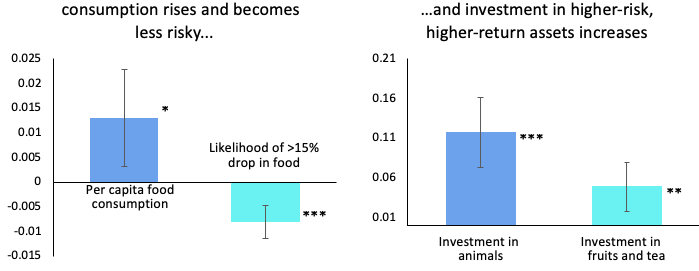
Government policies that facilitate internal migration not only drive economic growth, but also improve the welfare of rural households
While much of the current policy discussion surrounding migration focuses on people who cross international borders, nearly 75% of the one billion migrants worldwide relocate within their own country (Klugman 2009). The role of internal migration has important consequences for economic development. Beegle et al. (2011) found that internal migration in Tanzania was associated with a 36 percentage point increase in consumption growth. Research has also highlighted that barriers to migration prevent even more people from accessing the high returns to internal migration: Bryan et al. (2014) sought to lower the financial barrier to migration by providing rural Bangladeshi households with cash equal to the cost of a bus ticket if one household member migrated during the lean season. Households who sent migrants enjoyed higher consumption, and were more likely to send a seasonal migrant in subsequent years.
At the household level, the decision to migrate can be boiled down to the question: are the families of internal migrants better off than their peers who remained in their hometown? And if migration does improve households’ outcomes, an important subsequent question is: what role can government policies play in facilitating migration? In our paper, “Access to Migration for Rural Households,” we analysed data from agricultural households in China to shed light on these questions (Kinnan et al. 2018).
Our study: The impact of government resettlement policies
We demonstrate the important role of government policies in influencing migration in China (Kinnan et al. 2018). We study the consequences of a government programme that took place decades ago during the Cultural Revolution, called the sent-down youth (SDY) programme. This programme temporarily re-settled millions of urban youth in rural areas in the 1960s and 1970s, creating de facto urban-to-rural migration. Although virtually all of the urban youth eventually returned to their home cities, we find that the SDY programme had long-lasting effects on more recent patterns of migration in the opposite direction, rural-to-urban. This demonstrates that the connections created across places by the SDY programme persisted even once the sent-down youth themselves had long since returned home, and helped to facilitate migration decades later.
Our paper also shows the importance of modern government programmes. China has a household registration (hukou) system that allows residents to access social services only in the location where they are registered. For many decades, it was very difficult for an individual with a rural hukouto change to an urban one. We find that recent provincial reforms that made it easier for rural-to-urban migrants to obtain an urban hukou status led to increases in migration into those provinces.
We also examine how improved access to urban migration via hukoureforms affects the consumption patterns and labour allocation decisions of rural households. Importantly for evaluating the causal effect of access to migration, the hukou reforms we study are not in the provinces where the rural households initially reside. In fact, we show that using such “own-province” reforms would suffer from reverse causality—provinces that are already growing faster are more likely to implement hukou reforms. For instance, when the province of Sichuan is booming and there is more demand for urban labourers, there is a greater likelihood of towns in Sichuan implementing hukou reforms. But the incomes of rural Sichaunese households are already rising due to the economic boom. Examining reforms in other provinces with historical links forged by the SDY programme allows us to avoid this bias. For instance, urban youth from Sichuan were sent to Heilongjiang—over 2,000 miles (3,200 km) away—creating a lasting link between Sichuan and Heilongjiang. Using the reforms in Sichuan as a random shock to access to migration for households in Heilongjiang avoids reverse causality concerns, as we show.
Results: Rural households benefit
Using annual panel data covering 14,000 rural households from 19 provinces collected from 1995-2002, we show that rural households benefitted from access to migration in two ways.
- Migrant households had steadier consumption patterns: year after year, the amount of food families consumed was less variable, relative to non-migrant households. Migrant households also experienced fewer significant negative shocks to consumption, defined as a 15% or more decrease in consumption from the previous year.
- Migrant households shifted to higher-risk, higher-return activities, such as growing cash crops (e.g. tea and fruit) and raising livestock. Thus, it appears that the ability to have some household members migrate acts as a form of insurance that allows migrant households to pursue riskier activities with higher potential payoffs.
Figure 1 When households get access to migration…

Notes: Whiskers show 90% confidence intervals. Asterisks denote significance: *p < 0.10, **p < 0.05, ***p < 0.01.
Figure 1 shows how key outcomes change when households get increased access to migration. This increased access is in the form of one additional hukou reform implemented in a province that sent the sample average level of sent-down youth to the households’ home province. The bars show the change in the log of the outcome variable (except the likelihood of a drop in food consumption greater than 15%, which is in levels) associated with this change. The left-hand side of the figure shows that the level of food consumption increases, and the likelihood of a significant year-on-year drop in food consumption falls. Both the increase in average consumption and the fall in consumption variability are signs that access to migration increases welfare for rural households. The right-hand side sheds light on why consumption may increase: households increase their investment in higher-risk, higher-return assets – livestock, and fruits and tea.
Policy implications
Our research highlights the important role of internal migration in driving economic growth. It also demonstrates how policies that facilitate rural-to-urban migration, such as reforming the hukou system, can improve rural households’ economic standing. Finally, it shows that ties created across regions can persist for decades, and can shape the response to later reforms.
References
Beegle, K, J de Weerdt and S Dercon (2011), “Migration and economic mobility in Tanzania: Evidence from a tracking survey”, Review of Economics and Statistics 93(3): 1010–1033.
Bryan, G, S Chowdhury and A Mushfiq Mobarak (2014), “Underinvestment in a profitable technology: The case of seasonal migration in Bangladesh”, Econometrica 82(5): 1671–1748.
Kinnan, C, S Wang and Y Wang (2018), “Access to migration for rural households”, American Economic Journal-Applied Economics.
Klugman, J (2009), Overcoming barriers: Human mobility and development, UNDP-HDRO Human Development Report.



